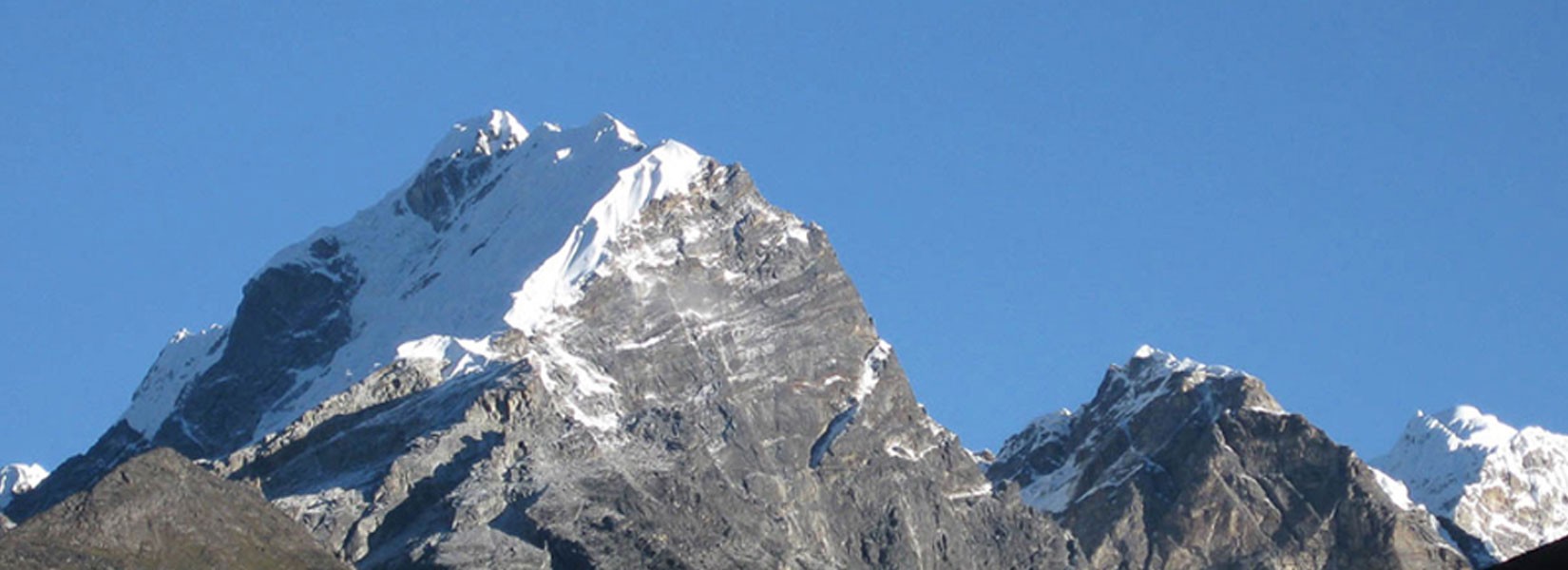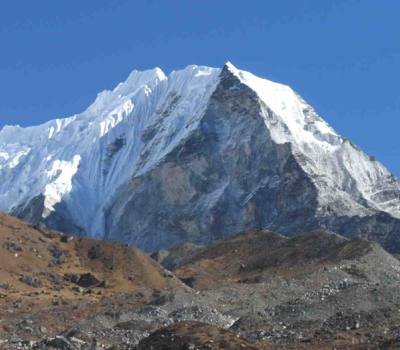Lobuche Peak Climbing
Experience the thrill of a lifetime with Lobuche Peak Climbing in Nepal. This peak climbing adventure takes you on a journey through Nepal's vast Himalayan landscape, where you'll discover new and familiar peaks alike. Trek to the famous Everest Base Camp and acclimatize gradually to the altitude, taking on beautiful hikes along the way. Once you've reached Kalapatthar, enjoy stunning views of Ama Dablam, Tawache, and other Himalayan peaks.
Lobuche east peak is an amalgamation of several small summits, and climbing to the top through steep snowy slopes is a challenge, but the reward is an accomplishment and a view that will stay with you for a lifetime. From the Lobuche base camp, you'll climb below the main glaciers and get access to the ridge overlooking Lobuche, where you'll see the breathtaking Khumbu glacier.
But Lobuche Peak Climbing isn't just about stunning mountain views. You'll also visit lively villages full of tradition and serene monasteries built on some of the toughest terrains. Capture the best pictures on the planet and create treasured memories that will last a lifetime.
At Destination Unlimited, we take pride in providing an unforgettable experience that you'll want to share with your friends and family. Our team has years of experience exploring the Himalayan terrain and an abundance of knowledge to ensure your safety and success in completing the climb. Trust us to provide the highest safety standards so you can push yourself to the challenge without worry.
Don't miss out on this fantastic opportunity for a once-in-a-lifetime adventure!
Trip Highlights of Lobuche Peak Climbing
Lobuche Peak, located in the Khumbu region of Nepal, is a popular climbing destination offering a mix of challenging terrain and stunning scenery. Here are some highlights of the Lobuche Peak climbing experience:
Scenic Beauty
- Panoramic Views: Offers breathtaking views of Everest, Lhotse, Nuptse, Ama Dablam, and Pumori.
- Khumbu Glacier: Climbers traverse the beautiful and vast Khumbu Glacier.
Cultural Experience
- Sherpa Culture: Interaction with the Sherpa community, experiencing their culture, traditions, and hospitality.
- Monasteries: Visits to ancient monasteries, including Tengboche Monastery, one of the most significant spiritual centers in the region.
Trekking Experience
- Everest Base Camp: The route often includes a trek to Everest Base Camp, providing a sense of the larger Everest expedition.
- Sagarmatha National Park: A UNESCO World Heritage Site, the park is rich in diverse flora and fauna.
Climbing Highlights
- Two Peaks: Lobuche consists of two main peaks, Lobuche East (6,119 meters) and Lobuche West (6,145 meters). Lobuche East is more popular among climbers.
- Technical Ascent: The climb involves moderate technical challenges, including steep ice and rock sections, making it suitable for climbers with some experience.
- Summit Experience: Reaching the summit provides a rewarding sense of achievement and spectacular panoramic views.
Logistical Support
- Experienced Guides: Professional climbing guides provide support and ensure safety throughout the expedition.
- Accommodation: Comfortable teahouses and camping facilities are available along the route.
Physical and Mental Challenge
- Altitude Acclimatization: The climb requires proper acclimatization to deal with the high altitude, adding to the adventure and challenge.
- Personal Achievement: Completing the climb is a significant personal accomplishment, contributing to one's mountaineering experience.
Lobuche Peak climbing offers a blend of adventure, natural beauty, and cultural richness, making it a memorable experience for climbers.
Outline Itinerary:
- Day 01: Arrival in Kathmandu.
- Day 02: Kathmandu tour and climb preparation
- Day 03: Fly to Lukla to start the Lobuche peak climbing trip.
- Day 04: to 11: Trek to Gorak Shep and excursion to Kalapatthar (5545m).
- Day 12: Excursion to the Everest Base Camp (5364m).
- Day 13: Trek to Lobuche Peak Base Camp (5500m).
- Day 14: to 15: Rest Acclimatization day
- Day 16: Summit the Lobuche East (6119m) and back to base camp
- Day 17: Lobuche Base Camp to Pangboche (3930m)
- Day 18: Pangboche to Namche Bazaar (3440m) (4-5 hours)
- Day 19: Namche Bazaar to Lukla (2800m) (6-7 hours)
- Day 20: Fly to Kathmandu.
- Day 21: In Kathmandu / Explore the city.
- Day 22: Final Departure.
Detail Itinerary
- Day 01 :Arrival in Kathmandu. Upon your arrival, our representative will greet you at the airport and escort you to your hotel. The afternoon will be free for you to get the first taste of Nepali life in Kathmandu. Dinner in the evening. O/N Hotel
- Day 02 :Kathmandu tour and climb preparation Today we will take a tour around the city of Kathmandu, visiting the major heritage sites such as; Pashupatinath, Boudhanath, Swayambhunath, Patan and Durbar Square. You will be guided and informed by a licensed guide. O/N Hotel
- Day 03 :Fly to Lukla to start the Lobuche peak climbing trip. Flying to Lukla through the glorious Himalayas and landing at one of the world’s most unique airport begin the third day. Followed by a beautiful 3-4-hour trek to the village of Phakding. O/N Lodge
- Day 04 :to 11: Trek to Gorak Shep and excursion to Kalapatthar (5545m). Over the next few days, we will trek to Gorak Shep, passing through the villages of; Namche Bazaar, Tengboche, Dingboche, Chhukung and Lobuche before reaching Gorak Shep. We move to Kalapatthar, which gives a dazzling perspective of different mountains, including Cho Oyu, Nuptse, and Lhotse.
- Day 12 :Excursion to the Everest Base Camp (5364m). We will climb to Everest Base Camp, with an awesome view of Pumori, Nuptse and obviously Mt Everest itself. The trail is lined with rocky moraine and reaches to the tented town where expedition groups stay.
- Day 13 :Trek to Lobuche Peak Base Camp (5500m). We begin walking a flat trail, which becomes steeper as we begin to climb towards high camp. The view of Lobuche glacier and the surrounding peaks can be explored. After base camp, the trail becomes quite rough and goes through rocky terrain.
- Day 14 :to 15: Rest Acclimatization day This is a rest day to acclimatize to the thin air, taking some local hikes through the gorgeous scenery. It also gives us the opportunity to be prepared for any bad weather or unforeseen circumstances to ensure our trek is unaffected.
- Day 16 :Summit the Lobuche East (6119m) and back to base camp We wake up early and set off, to avoid the challenging situation of sunrise, we will reach the pea and enjoy an ocean of natural beauties as we look down from 6,119m atop a glorious peak. Including a glorious panoramic which includes Mt. Everest. We at that point follow our steps back to base camp for the night.
- Day 17 :Lobuche Base Camp to Pangboche (3930m) We continue climbing down from the Lobuche high camp to Lobuche. It is our lunch point today. After that, we find the main trail of Everest base camp and continue trekking down to Pheriche and to Pangboche
- Day 18 :Pangboche to Namche Bazaar (3440m) (4-5 hours) Following the trail that we used for ascending, we reach to Tengboche and finally to the Namche Bazaar. It is pretty much a long walk but the excursion is fantastic.
- Day 19 :Namche Bazaar to Lukla (2800m) (6-7 hours) We stroll down through the lofty trail and make an exit from the Sagarmatha National Park and walk enjoyable towards the Dudh Koshi River. Intersection different suspension spans, we walk bit by bit to Lukla.
- Day 20 :Fly to Kathmandu. The last day involves flying back to Kathmandu (35 mins), checking into the hotel. The rest of the time in the capital city can be used to buy souvenirs and enjoy the sights and sounds.
- Day 21 :In Kathmandu / Explore the city. Today is another opportunity to explore the cultural capital of Nepal and witness the sounds and sights of the bustling Kathmandu lifestyle. It is a great opportunity to get a final taste of Nepali life.
- Day 22 :Final Departure. It’s the day to say bid farewell to the beautiful land of Nepal. Our company representative will take you to the airport. In case our country has enchanted you so much you desire to further explore, we are always there to extend your trip.
Cost Includes
- Hotel in Kathmandu with Breakfast
- All Airport Arrival and Transfer by Private Vehicle
- Tea-house Lodge during the Trekking
- Experienced, Government Licensed English-speaking Guide
- Domestic Airfare (Ktm-Luk-Ktm) with all airport taxes
- All your standard Meals (breakfast, lunch and dinner) with cup of tea or coffee during the trekking as per menu and Climbing Buffed
- All the Climbing staffs and their Expenses
- Trekker's information management system (TIMS) card fee.
- Sagarmatha National Park fees
- Sleeping bag for trekking
- Duffle bag and Tshirts
- Trip Map
- Peak climbing permit
- Sleeping bag
- First Aid Kit
- Good quality Tents and Kitchen utensils for camping
- Climbing equipment (Ropes, Tents, Kitchen Tents, Ice axe, Helmet etc.)
- Travel and rescue arrangements
- All the Government Taxes
Cost Excludes
- Your personal Equipment for Climbing such as Jackets, Boot etc.
- Nepalese visa fee (bring accurate USD cash and two passport photographs)
- International airfare to and from Kathmandu
- Khumbu Tax 20$
- Excess baggage charges (if you have more than 15 kg luggage, cargo charge is around $1.5 per kg)
- Extra night accommodation in Kathmandu because of early arrival, late departure, early return from mountain (due to any reason) than the scheduled itinerary
- Altitude chamber (PAC) or oxygen
- Lunch and evening meals in Kathmandu (and also in the case of early return from mountain than the scheduled itinerary)
- Travel and rescue insurance
- Personal expenses (phone calls, laundry, bar bills, battery recharge, extra porters, bottled or boiled water, shower, heater, etc.)
- Personal climbing equipment
- Personal climbing guide if requested
- Optional trips and sightseeing if extended
- Tips for guides and porters
1. What is Lobuche Peak?
Lobuche Peak is a prominent mountain in the Khumbu region of Nepal, offering two main summits: Lobuche East (6,119 meters) and Lobuche West (6,145 meters).
2. Which is the more popular peak to climb, Lobuche East or Lobuche West?
Lobuche East is more popular among climbers due to its relatively easier route and accessibility compared to Lobuche West, which is more technically challenging.
3. Do I need prior climbing experience to attempt Lobuche Peak?
Yes, prior climbing experience is recommended. Climbers should have basic mountaineering skills, including knowledge of using crampons, ice axes, and ropes.
4. What is the best time to climb Lobuche Peak?
The best time to climb Lobuche Peak is during the pre-monsoon (March to May) and post-monsoon (September to November) seasons. These periods offer stable weather and clear views.
5. How long does the Lobuche Peak expedition take?
The entire expedition typically takes around 18-21 days, including trekking to Everest Base Camp for acclimatization and the climb itself.
6. What is the difficulty level of the climb?
Lobuche East is considered a moderately challenging climb, suitable for climbers with some technical experience. The ascent involves steep sections of ice and rock.
7. What permits are required for climbing Lobuche Peak?
Climbers need several permits, including the Everest National Park Permit, TIMS (Trekkers' Information Management System) card, and a climbing permit specifically for Lobuche Peak.
8. Do I need to bring my own climbing gear?
While basic trekking gear is essential, most climbing gear such as crampons, harnesses, ice axes, and helmets can be rented in Kathmandu or arranged by your trekking company.
9. Is acclimatization necessary for Lobuche Peak?
Yes, proper acclimatization is crucial to prevent altitude sickness. The itinerary typically includes acclimatization days and a trek to higher altitudes, such as Everest Base Camp.
10. What kind of accommodation is available during the trek and climb?
Accommodation ranges from teahouses and lodges during the trek to camping in tents at higher altitudes near the base of the peak.
11. How physically fit do I need to be?
Climbers should be in good physical condition, capable of enduring long days of trekking and climbing. Cardiovascular fitness, strength, and stamina are essential.
12. What is the role of guides and porters in the expedition?
Experienced guides lead the expedition, ensuring safety and providing technical support. Porters assist by carrying heavy loads, allowing climbers to focus on the ascent.
13. Is travel insurance necessary for the climb?
Yes, comprehensive travel insurance that covers high-altitude climbing, emergency evacuation, and medical expenses is essential.
14. What kind of food is provided during the expedition?
Trekkers can expect a variety of meals, including local Nepali dishes and international cuisine. At higher altitudes, the menu may be more limited, but nutritious and energy-rich food is provided.
15. What should I pack for the expedition?
Essential items include layered clothing for varying temperatures, climbing gear, trekking boots, a sleeping bag, first aid kit, and personal items like sunscreen, sunglasses, and a camera.
16. Can I combine the Lobuche Peak climb with other trekking routes?
Yes, many climbers combine the Lobuche Peak climb with the Everest Base Camp trek, providing additional acclimatization and an enhanced trekking experience.
Quick Enquiry
Key Information
-
Trip Cost US$ 2500
-
Trip Duration 22 Days
-
Destination Nepal
-
Trip Difficulty Moderate
-
Trip Style Trekking
-
Accomodation Hotel + Lodges
-
Max Altitude 6119m
| No of people | Price P.P |
| 1-1 Pax | US$ 2500 |
| 2-4 | US$ 2500 |
| 6-8 | US$ 2300 |
Similar Trips
-
Island Peak Climbing
DURATION: 16 Days






